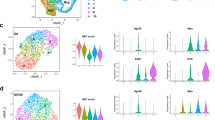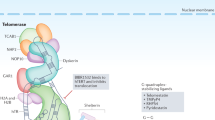Abstract
To test the role of telomere biology in T-cell prolymphocytic leukemia (T-PLL), a rare aggressive disease characterized by the expansion of a T-cell clone derived from immuno-competent post-thymic T-lymphocytes, we analyzed telomere length and telomerase activity in subsets of peripheral blood leukocytes from 11 newly diagnosed or relapsed patients with sporadic T-PLL. Telomere length values of the leukemic T cells (mean±s.d.: 1.53±0.65 kb) were all below the 1st percentile of telomere length values observed in T cells from healthy age-matched controls whereas telomere length of normal T- and B cells fell between the 1st and 99th percentile of the normal distribution. Leukemic T cells exhibited high levels of telomerase and were sensitive to the telomerase inhibitor BIBR1532 at doses that showed no effect on normal, unstimulated T cells. Targeting the short telomeres and telomerase activity in T-PLL seems an attractive strategy for the future treatment of this devastating disease.
This is a preview of subscription content, access via your institution
Access options
Subscribe to this journal
Receive 12 print issues and online access
$259.00 per year
only $21.58 per issue
Buy this article
- Purchase on Springer Link
- Instant access to full article PDF
Prices may be subject to local taxes which are calculated during checkout






Similar content being viewed by others
References
Matutes E, Brito-Babapulle V, Swansbury J, Ellis J, Morilla R, Dearden C et al. Clinical and laboratory features of 78 cases of T-prolymphocytic leukemia. Blood 1991; 78: 3269–3274.
Dearden CE . T-cell prolymphocytic leukemia. Med Oncol 2006; 23: 17–22.
Dearden CE, Matutes E, Cazin B, Tjonnfjord GE, Parreira A, Nomdedeu B et al. High remission rate in T-cell prolymphocytic leukemia with CAMPATH-1 H. Blood 2001; 98: 1721–1726.
Moyzis R, Buckingham J, Cram L, Dani M, Deaven L, Jones M et al. A highly conserved repetitive DNA sequence, (TTAGGG)n, present at the telomeres of human chromosomes. Proc Natl Acad Sci USA 1988; 85: 6622–6626.
Smogorzewska A, de Lange T . Regulation of telomerase by telomeric proteins. Annu Rev Biochem 2004; 73: 177–208.
Griffith J, Comeau L, Rosenfield S, Stansel R, Bianchi A, Moss H et al. Mammalian telomeres end in a large duplex loop. Cell 1999; 97: 503–514.
Campisi J . Cancer and ageing: rival demons? Nat Rev Cancer 2003; 3: 339–349.
d'Adda dF, Reaper PM, Clay-Farrace L, Fiegler H, Carr P, von Zglinicki T et al. A DNA damage checkpoint response in telomere-initiated senescence. Nature 2003; 426: 194–198.
Watson JD . Origin of concatameric T4 DNA. Nat New Biol 1972; 239: 197–201.
Olovnikov AM . A theory of marginotomy. The incomplete copying of template margin in enzymic synthesis of polynucleotides and biological significance of the phenomenon. J Theor Biol 1973; 41: 181–190.
Lansdorp PM . Major cutbacks at chromosome ends. Trends Biochem Sci 2005; 30: 388–395.
Harley CB, Futcher AB, Greider CW . Telomeres shorten during ageing of human fibroblasts. Nature 1990; 345: 458–460.
Martens UM, Chavez EA, Poon SSS, Schmoor C, Lansdorp PM . Accumulation of short telomeres in human fibroblasts prior to replicative senescence. Exp Cell Res 2000; 256: 291–299.
Artandi SE, Chang S, Lee SL, Alson S, Gottlieb GJ, Chin L et al. Telomere dysfunction promotes non-reciprocal translocations and epithelial cancers in mice. Nature 2000; 406: 641–645.
Blackburn EH . Telomerases. Annu Rev Biochem 1992; 61: 113–129.
Counter CM, Gupta J, Harley CB, Leber B, Bacchetti S . Telomerase activity in normal leukocytes and in hematologic malignancies. Blood 1995; 85: 2315–2320.
Engelhardt M, Mackenzie K, Drullinsky P, Silver RT, Moore MA . Telomerase activity and telomere length in acute and chronic leukemia, pre- and post-ex vivo culture. Cancer Res 2000; 60: 610–617.
Kelland LR . Overcoming the immortality of tumour cells by telomere and telomerase based cancer therapeutics—current status and future prospects. Eur J Cancer 2005; 41: 971–979.
Shay JW, Wright WE . Telomerase therapeutics for cancer: challenges and new directions. Nat Rev Drug Discov 2006; 5: 577–584.
Mergny JL, Riou JF, Mailliet P, Teulade-Fichou MP, Gilson E . Natural and pharmacological regulation of telomerase. Nucleic Acids Res 2002; 30: 839–865.
Asai A, Oshima Y, Yamamoto Y, Uochi TA, Kusaka H, Akinaga S et al. A novel telomerase template antagonist (GRN163) as a potential anticancer agent. Cancer Res 2003; 63: 3931–3939.
Tauchi T, Shin-ya K, Sashida G, Sumi M, Nakajima A, Shimamoto T et al. Activity of a novel G-quadruplex-interactive telomerase inhibitor, telomestatin (SOT-095), against human leukemia cells: involvement of ATM-dependent DNA damage response pathways. Oncogene 2003; 22: 5338–5347.
Hahn WC, Stewart SA, Brooks MW, York SG, Eaton E, Kurachi A et al. Inhibition of telomerase limits the growth of human cancer cells. Nat Med 1999; 5: 1164–1170.
Zhang X, Mar V, Zhou W, Harrington L, Robinson MO . Telomere shortening and apoptosis in telomerase-inhibited human tumor cells. Genes Dev 1999; 13: 2388–2399.
Röth A, Yssel H, Pene J, Chavez EA, Schertzer M, Lansdorp PM et al. Telomerase levels control the lifespan of human T lymphocytes. Blood 2003; 102: 849–857.
Röth A, Vercauteren S, Sutherland HJ, Lansdorp PM . Telomerase is limiting the growth of acute myeloid leukemia cells. Leukemia 2003; 17: 2410–2417.
Damm K, Hemmann U, Garin-Chesa P, Hauel N, Kauffmann I, Priepke H et al. A highly selective telomerase inhibitor limiting human cancer cell proliferation. EMBO J 2001; 20: 6958–6968.
Ohyashiki JH, Sashida G, Tauchi T, Ohyashiki K . Telomeres and telomerase in hematologic neoplasia. Oncogene 2002; 21: 680–687.
Gesk S, Martin-Subero JI, Harder L, Luhmann B, Schlegelberger B, Calasanz MJ et al. Molecular cytogenetic detection of chromosomal breakpoints in T-cell receptor gene loci. Leukemia 2003; 17: 738–745.
Röth A, Baerlocher GM, Schertzer M, Chavez E, Dührsen U, Lansdorp PM . Telomere loss, senescence, and genetic instability in CD4+ T lymphocytes overexpressing hTERT. Blood 2005; 106: 43–50.
Baerlocher GM, Vulto I, de Jong G, Lansdorp PM . Flow cytometry and FISH to measure the average length of telomeres (flow FISH). Nat Protocols 2006; 1: 2365–2376.
Yamaguchi H, Calado RT, Ly H, Kajigaya S, Baerlocher GM, Chanock SJ et al. Mutations in TERT, the gene for telomerase reverse transcriptase, in aplastic anemia. N Engl J Med 2005; 352: 1413–1424.
Alter BP, Baerlocher GM, Savage SA, Chanock SJ, Weksler BB, Willner JP et al. Very short telomere length by flow fluorescence in situ hybridization identifies patients with dyskeratosis congenita. Blood 2007; 110: 1439–1447.
Feldser DM, Hackett JA, Greider CW . Telomere dysfunction and the initiation of genome instability. Nat Rev Cancer 2003; 3: 623–627.
Croce CM, Isobe M, Palumbo A, Puck J, Ming J, Tweardy D et al. Gene for alpha-chain of human T-cell receptor: location on chromosome 14 region involved in T-cell neoplasms. Science 1985; 227: 1044–1047.
Soulier J, Pierron G, Vecchione D, Garand R, Brizard F, Sigaux F et al. A complex pattern of recurrent chromosomal losses and gains in T-cell prolymphocytic leukemia. Genes Chromosomes Cancer 2001; 31: 248–254.
Callen E, Surralles J . Telomere dysfunction in genome instability syndromes. Mutat Res 2004; 567: 85–104.
Masutomi K, Yu EY, Khurts S, Ben Porath I, Currier JL, Metz GB et al. Telomerase maintains telomere structure in normal human cells. Cell 2003; 114: 241–253.
Blackburn EH . Switching and signaling at the telomere. Cell 2001; 106: 661–673.
Blasco MA . Telomerase beyond telomeres. Nat Rev Cancer 2002; 2: 627–633.
Blackburn EH . Telomere states and cell fates. Nature 2000; 408: 53–56.
El Daly H, Kull M, Zimmermann S, Pantic M, Waller CF, Martens UM . Selective cytotoxicity and telomere damage in leukemia cells using the telomerase inhibitor BIBR1532. Blood 2005; 105: 1742–1749.
Ward RJ, Autexier C . Pharmacological telomerase inhibition can sensitize drug-resistant and drug-sensitive cells to chemotherapeutic treatment. Mol Pharmacol 2005; 68: 779–786.
Acknowledgements
This paper is dedicated to Professor Günter Brittinger on the occasion of his 75th birthday. We thank Anja Führer and Margret Gottlieb for their expert technical assistance. We are grateful to Boehringer Ingelheim Pharma KG (Biberach, Germany) for providing us with BIBR1532. We thank Dr Lana Harder for her help with cytogenetic analyses, Dr Nückel for helping with statistical analysis and Dr Ludger Klein-Hitpass (Institute for Cell Biology, Essen, Germany) for his help with hTERT RT-PCR. This work was supported by a grant from the Bernese Cancer League (to GMB).
Author information
Authors and Affiliations
Corresponding authors
Additional information
Contributions: AR, JD and GMB designed the research; AR, HH, SB and GMB performed the experiments and collected the data; AR, JD, RS and GMB analyzed and interpreted the data; AR, RS, UD, PML and GMB wrote the paper.
Rights and permissions
About this article
Cite this article
Röth, A., Dürig, J., Himmelreich, H. et al. Short telomeres and high telomerase activity in T-cell prolymphocytic leukemia. Leukemia 21, 2456–2462 (2007). https://doi.org/10.1038/sj.leu.2404968
Received:
Revised:
Accepted:
Published:
Issue Date:
DOI: https://doi.org/10.1038/sj.leu.2404968
Keywords
This article is cited by
-
The Dual Role of ROS in Hematological Malignancies: Stem Cell Protection and Cancer Cell Metastasis
Stem Cell Reviews and Reports (2020)
-
Actionable perturbations of damage responses by TCL1/ATM and epigenetic lesions form the basis of T-PLL
Nature Communications (2018)
-
MST-312 induces G2/M cell cycle arrest and apoptosis in APL cells through inhibition of telomerase activity and suppression of NF-κB pathway
Tumor Biology (2015)
-
Telomeres and prognosis in patients with chronic lymphocytic leukaemia
International Journal of Hematology (2011)
-
Telomerase and cancer therapeutics
Nature Reviews Cancer (2008)



